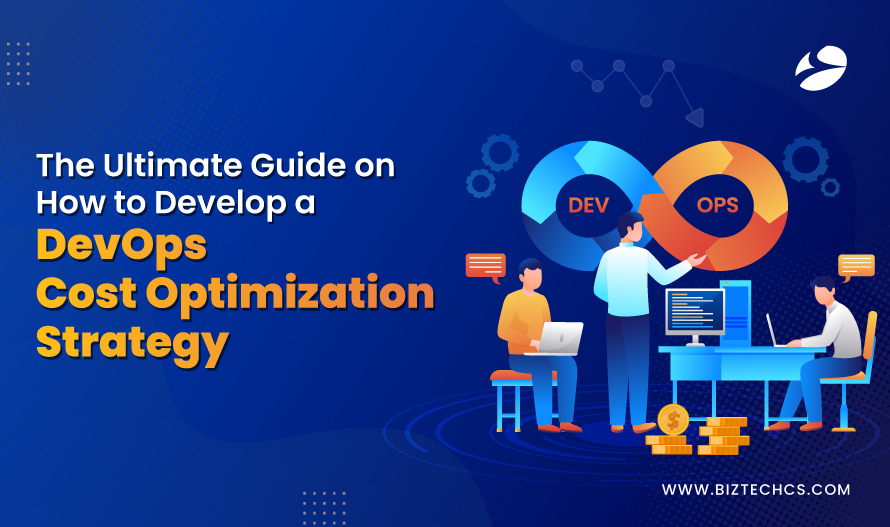1923
The Ultimate Guide on How to Develop a DevOps Cost Optimization Strategy
8 min read
1923
8 min read
Table of Content

In today’s competitive technological environment, embracing cost effectiveness without compromising productivity should be everyone’s goal.
DevOps has helped enhance development and operations, but the adoption of a robust cost optimization model can be an issue.
The goal of this guide is to provide you with actionable recommendations and realistic strategies for dealing with costs in DevOps.
We will also discuss how to properly analyze costs, utilize tools, and make informed decisions about the costs involved.
At the end of this guide, you will be able to enhance your DevOps while ensuring quality delivery.
Whether you are a complete beginner to online marketing or want to fine-tune your current approach, this guide will give you the basic information you require.
Now let’s explore the ultimate DevOps cost optimization process that delivers the best for your business.
Cost optimization is an area where DevOps contributes by interlinking software development and IT operations and improving the efficiency of processes.
DevOps minimizes the use of labor, making operating expenses lower by about one-third, as estimated by Gartner.
Better organization of development and operations leads to the use of DevOps, which also decreases system downtime and increases system reliability, which in turn saves money.
Also, infrastructure as code makes resource usage more efficient and clouds cost savings by up to 25%.
Monitoring and feedback mechanisms also guarantee that resources are utilized in the right manner and thus reduce on costs.
Hence, DevOps does not only enhance delivery speed but it also reduces cost at every stage of application development.
Continuous Integration and Continuous Deployment eliminate the entire cycle of an agile software development framework by reducing the testing and development cycle time hence improving the speed of identifying and fixing problems.
It minimizes tedious work, enabling efficiency and lowering cost. Since testing is continuous in CI/CD, bugs are pointed out upfront, avoiding costly, time-consuming rework at a later stage.
It also accelerates the release of new features or bug patches, enabling businesses to adapt to market forces without increasing expenses.
Moreover, with CI/CD in place, a team is capable of releasing more frequent but smaller and less risky changes rather than waiting for a big, risky release.
In short, CI/CD enhances the efficiency of the development process across the various stages, thus reducing operating expenses.
Infrastructure as Code (IaC) is a methodology for managing and provisioning infrastructures, similar to how software is managed and built.
IaC eliminates the need for manual resource management intervention, reducing the risk of costly human errors. DevOps automation minimizes downtime by avoiding manual corrections and ensuring consistency in infrastructure deployment.
This makes it easy for teams to stand up, scale, or even dismantle environments, which is efficient in resource utilization and costs.
IaC also helps guarantee that setups are consistent and identical across environments, thus excluding the additional costs that arise due to differences between them.
In addition, it is easy to scale up, meaning that only the required resources are used, to manage cloud costs. IaC is advantageous in managing infrastructure in a DevOps setup since costs are low.
Testing automation in a DevOps process is, therefore, cost-efficient in delivering quality and speed in software production.
This way it eliminates the need for manual testing, which might be costly and prone to many errors.
This means that problems are detected while in the development phase, preventing high costs of rectifying the bugs.
They can be done many times and will always produce accurate results without the need for extra resources.
When one has invested in automation, costs are cut in the long run since less involvement of human interference is required.
Lastly, automated testing simplifies the development process and produces more frequent releases with minimum defects and costs.
Both monitoring and logging continue to be crucial strategies in the cost optimization of DevOps.
System performance logs should be regularly recorded and studied to discover shortcomings or potential setbacks quickly.
If implemented, it becomes easy to match organizational resources with requirements, avoiding wastage.
To analyze trends, debug issues quicker, and prevent excruciating long downtimes which might be expensive.
Self-configuration from monitoring tools can help avoid over-subscription or under-subscription of resources.
In essence, these practices make it easier to sustain a balance between performance and costs.
Microservices architecture involves breaking down an application into smaller, independent services that can be developed, maintained, and updated separately.
Each service focuses on a specific function, enabling greater flexibility and scalability in software development.
This approach helps teams achieve better cost control, enabling scaling only certain microservices that require more resources instead of the overall application.
It also eliminates the need for highly expensive and large hardware and computing resources because each service can be hosted in lightweight and affordable environments.
Furthermore, when performance issues emerge, microservices allow for a clear and targeted look at areas that require optimization and a more focused supply of resources.
This way, one service will not affect the other or cause downtime, and the amount of money it consumes can be limited.
Microservices improve software development and reduce operational costs by breaking large applications into smaller, more manageable components. This approach enhances flexibility and simplifies maintenance.
Containerization and orchestration are cost-effective solutions in DevOps since they efficiently use resources.
Applications with dependencies are bundled in containers independent of the underlying environment, thus minimizing the requirements for dedicated hardware.
With Kubernetes, such containers can be deployed, scaled, and managed with the help of orchestration tools, and resources can be utilized only when required.
This dynamic allocation helps to avoid wastage and eliminate the need to over-provision, which might be costly.
It also assists in attaining increased server occupancy levels, thus reducing cloud or hardware expenses.
In general, containerization and orchestration help improve efficiency and reduce cost of processes while also making them scalable.
Another DevOps cost optimization technique involves implementing continuous feedback loops across all software development and operations teams. This approach ensures ongoing improvements and efficient resource usage, ultimately reducing costs.
Frequently checking usage and acquiring user feedback makes it easier for developers to notice flaws in the design. This also enables the teams to address problems faster, enhance resource efficiency, and contain waste, thus cutting costs.
The automation tools and monitoring systems help in the collection of real-time data that is used in making these enhancements.
Whenever alteration occurs, the feedback and improvement loop commences, making the system consistently efficient and even cheap.
Overall, this strategy effectively sustains high performance with the least resource utilization.
Essentially, in the DevOps approach, collaboration and communication drive cost optimization.
Some related examples of teamwork include: when a team is integrated, it is able to recognize gaps and address them, thus saving a lot of time and resources.
Effective communication reduces the chances of people not focusing on the right goals and objectives, preventing work duplication.
Teams can improve efficiency and reduce costly mistakes in deploying new products and services by utilizing tools that enable continuous communication and collaboration. These tools streamline workflows and enhance coordination across the team.
This also provides feedback that can be incorporated into subsequent work to save time and money within the project.
Finally, when collaboration and communication are good, the teams will work more effectively and not necessarily longer, which is another way of implying cost cutting.
DevSecOps is about incorporating security at the core of development and operation processes to enhance the security of applications.
Security checks are routinely integrated into the process to detect weaknesses before implementation. This proactive approach helps prevent large-scale security breaches.
This proactive approach accelerates secure software delivery by addressing security issues early in development.
As a result, teams minimize delays that typically arise from fixing security problems in the later stages of the software development life cycle.
The continuous monitoring and testing within DevSecOps also guarantee that any new threats are detected on time and addressed.
Consequently, companies can improve their financial performance by decreasing the costs linked to security threats and compliance.
The inclusion of security in DevOps is a best practice that would enhance the development of secure software and the system’s agility.
Adaptability and scalability are interactive DevOps strategies, and these approaches help to boost a corporate balance sheet.
Scalability is the concept of increasing the amount of workload while maintaining the service’s positivity when systems bring in extra resources.
One key value of DevOps is the ability to adapt quickly to changes in processes, tools, deployments, and updates. This flexibility ensures that such changes have minimal impact on the overall system.
When implemented, these practices enable the organization to reduce idle time and increase delivery turnaround, thereby cutting costs.
For organizations to stay relevant in the market, they must be able to respond quickly to market conditions and increase or decrease output as needed. This leads to increased revenue and profitability, which is the main aim of any organization.
Effectual cost management and optimization in DevOps is a beneficial approach to enhancing a company’s net revenue.
Therefore, the infrastructure usage metrics allow teams to detect and remove waste, which could include unused resources or nonessential services.
Automated scaling prevents resource waste, as resources are adjusted according to actual needs rather than predefined proportions.
Additional utilization of cost optimization measures such as spot instances and reserved instances helps to lower the cost even further while maintaining optimal performance.
Real-time feedback enables the teams to constantly modify their spending, thereby avoiding a mismatch with the business objectives.
Ultimately, such practices are productive and contribute to a more efficient workflow, resulting in improved financial performance.
One of the most important DevOps practices is continuous learning and improvement since the teams have to be ready to address new challenges.
If companies can make their team members continuously learn and improve the kind of work they do, any change can be easily explained and overcome. This approach leads to improved productivity and successful delivery of quality software in minimal time.
When everyone is committed to continuous improvement, it is easier to point out a problem, fix it, and go back to delivering services, which takes little time and little money.
It improves customer satisfaction and long-term bottom-line returns. In other words, team members learn and improve during their working process, making the team stronger and the business more effective.
In conclusion, developing a DevOps cost optimization plan is essential for staying competitive and making wise investments in the rapidly evolving tech market.
Focusing on continuous improvement allows organizations to maximize resource utilization while maintaining high performance. This approach ensures that companies can adapt effectively without compromising on efficiency.
Maintaining a security strategy requires regular inspections and updates to align with technological advancements and evolving business needs. Continuous evaluation and modification are essential to ensure the strategy remains effective and relevant.
Effective communication and sharing of information across the various teams will also add more value to the strategy.
Finally, an effective cost optimization strategy enhances effective cost and the efficiency of the overall DevOps process.
It is crucial to remain active in this type to ensure your organization does not lag behind competitors.
People Process and Products is a model known as the 3 P’s of DevOps where People means collaboration, Process means the flow of work, and Products means the right tools for automation.
Some of the common stages of the DevOps life cycle include continuous development, integration, testing, deployment, monitoring, and feedback mechanisms.
When it comes to the best CI/CD tool, it varies depending on the specific situation, but Jenkins is one of the most popular because it is versatile and has a large user base.

Odoo
27
By Uttam Jain

Odoo
27
By Uttam Jain

Odoo
26
By Uttam Jain